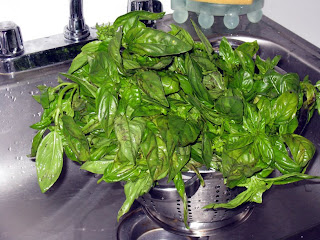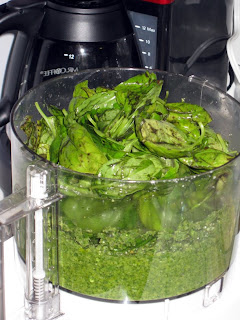 Organic garlic and basil are abundant at the local farmers market. Tomato plants are still churning out beautifully colored fruit. Peppers are running amok and onions hog the lion's share of every vendor's tabletop. All proving one thing: the god of late summer is most assuredly Italian. Organic garlic and basil are abundant at the local farmers market. Tomato plants are still churning out beautifully colored fruit. Peppers are running amok and onions hog the lion's share of every vendor's tabletop. All proving one thing: the god of late summer is most assuredly Italian.
Which brings us to today's lesson: pesto. My friend Google offered up some 845,000 odd pages on pesto's storied past. It's worth the trouble of reading a couple-hundred thousand of them. It's an inspiring chronicle and has ignited the spark of my true calling, Food Alchemist. I won't bore you with the 700-year history, but will tell you pesto was perfected in the Leguria region of Italy. |
| |
| Authentic pesto is prepared in a wide marble mortar with a large wooden pestle. Tender, young basil leaves are crushed with garlic to form a paste. There are some very specific hints about wrist action in this initial step, but YouTube has yet to post a video demonstration. Pine nuts are then ground into the paste, and olive oil added to form a sauce. Finally, cheese is stirred in to thicken and bind all the ingredients together. |
| |
| I now must have Ligurian pesto before I die, or spend a purgatorial existence in limbo wondering "what if, what if!" Unfortunately, I don't own a horse trough marble mortar and a Billy club wooden pestle, but here's how we roll in the Boogie Down. |
| |
 I hope you're not looking for measurements on this one. I simply don't have them. I just do what feels right and make adjustments at the end. I can tell you one thing: practice makes perfect. As a peace offering to you, my loyal readers, here is a list of ingredients: I hope you're not looking for measurements on this one. I simply don't have them. I just do what feels right and make adjustments at the end. I can tell you one thing: practice makes perfect. As a peace offering to you, my loyal readers, here is a list of ingredients: - Fresh basil
- Pignoli
- Parmesan cheese
- Whole garlic cloves
- Extra virgin olive oil
|
| |
| Making pesto is easy; it's the prep work that'll kill ya. I start by thoroughly washing the basil. The last thing you want is grit in your pesto so be very conscientious with this step. I soak my basil in a cold water bath for several minutes, changing the water a couple of times. Finally, the plants get a lengthy rinse before I set them aside in a colander to drain. As if that weren't fastidious enough, I pat the leaves dry with paper towels before mixing with my other ingredients. |
| |
   |
| |
| While the basil leaves are drying, prep the cheese and pine nuts. I've been using fresh, whole Parmigiano Reggiano cheese since I started making my own pesto, but traditionalist use a ratio of Grana Padano (unpasteurized cow's milk cheese), and Pecorino (sheep's milk cheese). Break up a wedge of Parmesan into manageable chucks and place in a food processor. After my two-burner stovetop grill/griddle, the food processor is my favorite tool in the kitchen. It makes grating hard cheeses a cinch and allows real control over how fine a grate you want. The machine will come in handy later in the process too. |
| |
| Toast the pignoli in a dry skillet, tossing frequently. I've warned you previously, do not take your eyes off pine nuts while they're over a fire. They want to burn, and popcorn notwithstanding, scorched pignoli will ruin everything it meets. Once they've developed a color that you like, remove from the heat and set aside. |
| |
| Now you're ready to make pesto. Place basil leaves (separated from the stems) into the bowl of your food processor. Add a handful of pine nuts and a couple of heaping tablespoons of grated cheese. Toss in whole garlic cloves deprived of their paper skins. Put the top on the food processor and while pulsing the blade, very slowly drizzle olive oil into the bowl using the small opening in the top of the lid. A thick but not solid consistency makes for a pleasing sauce. You certainly don't want anything runny or oily. Repeat the process until all the basil , pignoli and garlic have been very finely chopped and you have a smooth textured sauce. |
| |
  |
| |
| Pesto and pasta go together like peas and carrots, Laurel and Hardy, chocolate and peanut butter. Select a pasta with some texture to it like fusilli (corkscrew) or farfalle (bow-tie). Did you know farfalla actually translates to "butterfly" and not "bow-tie" in Italian? A textured noodle allows the pesto to stick to the pasta. |
| |
| You can dollop pesto onto caprese and bruschetta in the place of basil leaves. Those fruits and nuts out in California use pesto as a substitute for tomato sauce on pizza. The same folks who brought you the pineapple and Canadian bacon pizza, but I'm just sayin'. |
| |
| Stow pesto away in the freezer by sealing in an airtight container. Just make sure there is a layer of olive oil on top first. It acts as a sealant and preservative until you're ready to use your sauce. Never nuke your pesto or heat it up on its own. The ingredients separate and you end up with a real mess on your hands. Allow the pesto to come up to room temperature before use. |
| |
| The taste of fresh pesto will remind you of rolling around in hay fields, or bring to mind the minty, herbal bite in a mojito without that lighter fluid lockjaw one experiences from the cheap rum. Homemade pesto has an arresting freshness that you just can't find in processed sauces, so gather up your herbs and cheeses and get going. |
| |
| Thanks for taking the time - Blog O. Food |
| |
3 comments:
It looks like a visit to the farmers market may be in order for this weekend. It's great to see that this site is working out so well. I can't wait to share it with all my new friends!
I just made pesto last week...and served it with Farfalle! The house we moved into has Rosemary, Parsley, and Basil in full bloom and I had to use up a lot of basil quickly because it was flowering (I was told that was bad...). Anyway my one issue with pesto is that for some reason the basil flavor is always muted...why is that? I love the bold yummy flavor but it is never bold enough for me. Suggestions?
MORE basil flavor? I have to admit, that's a new one for me. I would start by making sure you have a light, fruity extra virgin olive oil. California is making very good oil these days, so you don't have to spend a small fortune on imported stuff. There are some heavy hitters out there, so don't be afraid to do the ol' pinky test.
I've heard patting basil leaves with a moist paper towel instead the rigors of a full rinse preserves some of the flavor, but the hilarity of that particular mental image has always prevented me from trying the idea.
Lastly, if you want more basil flavor, adjust your ingredients. In other words, add more basil!
Let me if this was of any help, and thanks!
Post a Comment